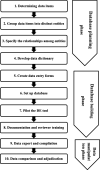Data extraction and comparison for complex systematic reviews: a step-by-step guideline and an implementation example using open-source software
- PMID: 38041161
- PMCID: PMC10691069
- DOI: 10.1186/s13643-023-02322-1
Data extraction and comparison for complex systematic reviews: a step-by-step guideline and an implementation example using open-source software
Abstract
Background: Data extraction (DE) is a challenging step in systematic reviews (SRs). Complex SRs can involve multiple interventions and/or outcomes and encompass multiple research questions. Attempts have been made to clarify DE aspects focusing on the subsequent meta-analysis; there are, however, no guidelines for DE in complex SRs. Comparing datasets extracted independently by pairs of reviewers to detect discrepancies is also cumbersome, especially when the number of extracted variables and/or studies is colossal. This work aims to provide a set of practical steps to help SR teams design and build DE tools and compare extracted data for complex SRs.
Methods: We provided a 10-step guideline, from determining data items and structure to data comparison, to help identify discrepancies and solve data disagreements between reviewers. The steps were organised into three phases: planning and building the database and data manipulation. Each step was described and illustrated with examples, and relevant references were provided for further guidance. A demonstration example was presented to illustrate the application of Epi Info and R in the database building and data manipulation phases. The proposed guideline was also summarised and compared with previous DE guidelines.
Results: The steps of this guideline are described generally without focusing on a particular software application or meta-analysis technique. We emphasised determining the organisational data structure and highlighted its role in the subsequent steps of database building. In addition to the minimal programming skills needed, creating relational databases and data validation features of Epi info can be utilised to build DE tools for complex SRs. However, two R libraries are needed to facilitate data comparison and solve discrepancies.
Conclusions: We hope adopting this guideline can help review teams construct DE tools that suit their complex review projects. Although Epi Info depends on proprietary software for data storage, it can still be a potential alternative to other commercial DE software for completing complex reviews.
Keywords: Complex; Data extraction; Database; Epi Info; Guideline; R; Systematic review.
© 2023. The Author(s).
Conflict of interest statement
The authors declare that they have no competing interests.
Figures




Similar articles
-
The future of Cochrane Neonatal.Early Hum Dev. 2020 Nov;150:105191. doi: 10.1016/j.earlhumdev.2020.105191. Epub 2020 Sep 12. Early Hum Dev. 2020. PMID: 33036834
-
Folic acid supplementation and malaria susceptibility and severity among people taking antifolate antimalarial drugs in endemic areas.Cochrane Database Syst Rev. 2022 Feb 1;2(2022):CD014217. doi: 10.1002/14651858.CD014217. Cochrane Database Syst Rev. 2022. PMID: 36321557 Free PMC article.
-
Beyond the black stump: rapid reviews of health research issues affecting regional, rural and remote Australia.Med J Aust. 2020 Dec;213 Suppl 11:S3-S32.e1. doi: 10.5694/mja2.50881. Med J Aust. 2020. PMID: 33314144
-
The Benefits and Challenges of Using Multiple Sources of Information about Clinical Trials [Internet].Washington (DC): Patient-Centered Outcomes Research Institute (PCORI); 2018 Mar. Washington (DC): Patient-Centered Outcomes Research Institute (PCORI); 2018 Mar. PMID: 37043591 Free Books & Documents. Review.
-
Machine learning computational tools to assist the performance of systematic reviews: A mapping review.BMC Med Res Methodol. 2022 Dec 16;22(1):322. doi: 10.1186/s12874-022-01805-4. BMC Med Res Methodol. 2022. PMID: 36522637 Free PMC article. Review.
References
-
- Chandler J, Churchill R, Higgins JPT, Lasserson T, Tovey D. Methodological expectations of Cochrane intervention reviews. Version 1.05, January 2018. 2019. Available at http://community.cochrane.org/mecir-manual. Accessed 18 Nov 2019.
-
- Li T, Higgins JP, Deeks JJ. Chapter 5: Collecting data. In: Higgins JPT, Thomas J, Chandler J, Cumpston M, Li T, Page MJ, et al., editors. Cochrane handbook for systematic reviews of interventions 63 (updated February 2022). London: Cochrane; 2022. p. 109–41.
-
- Aromataris E, Munn Z. JBI manual for evidence synthesis. 2020. Available from https://synthesismanual.jbi.global. Accessed July 2020.
Publication types
MeSH terms
LinkOut - more resources
Full Text Sources
Research Materials

